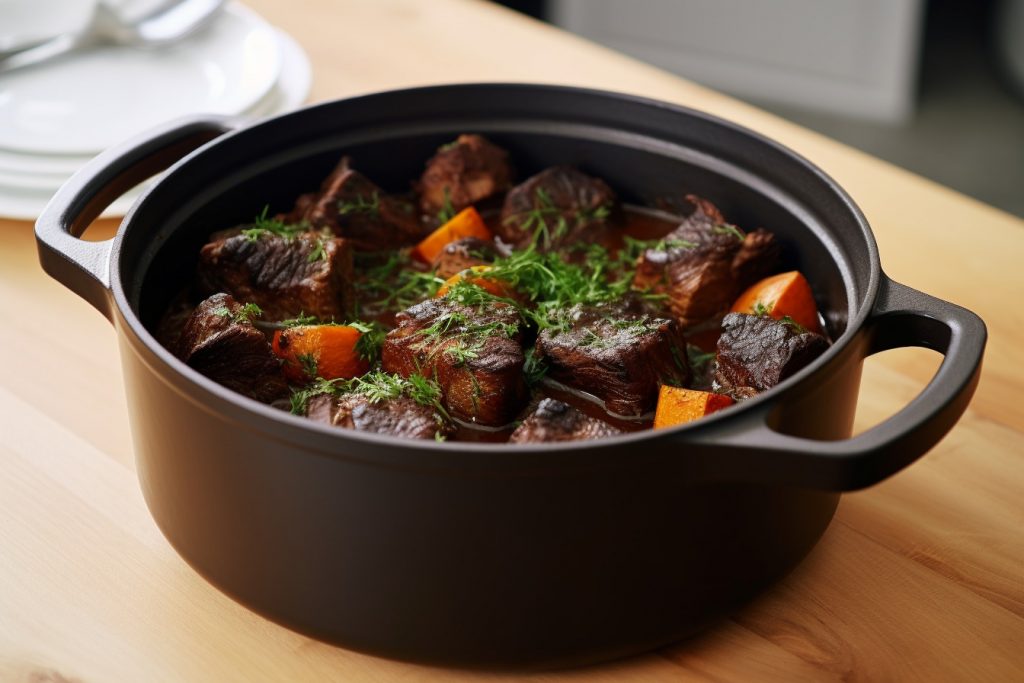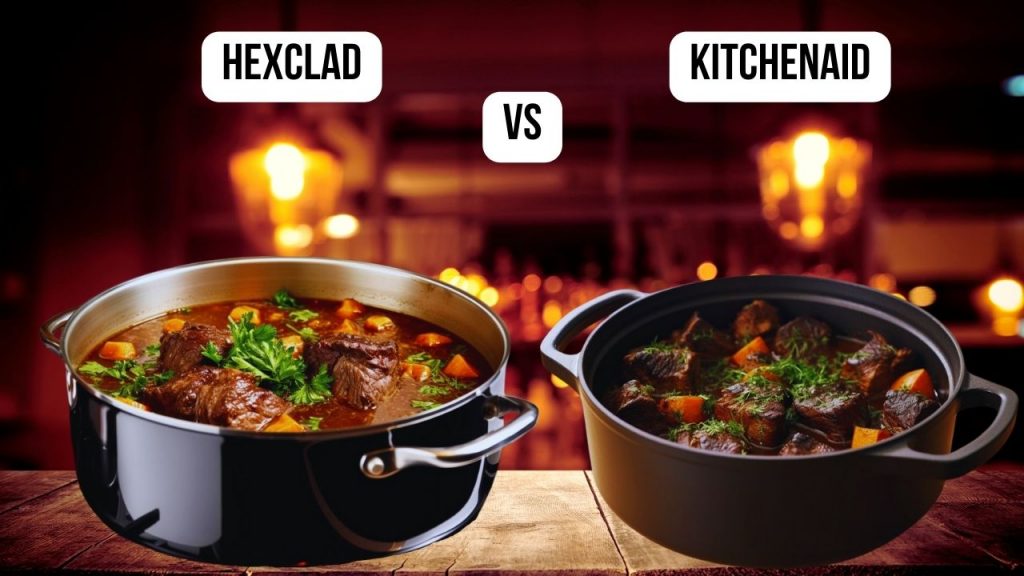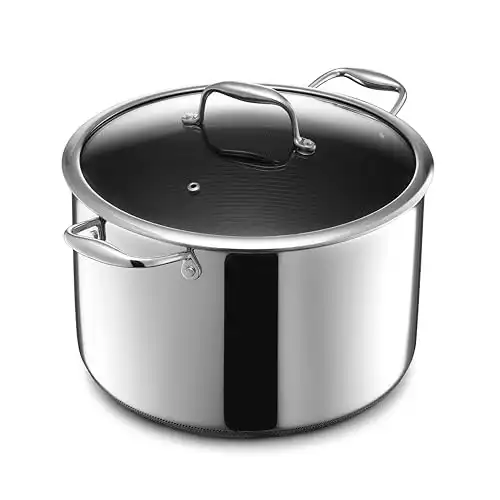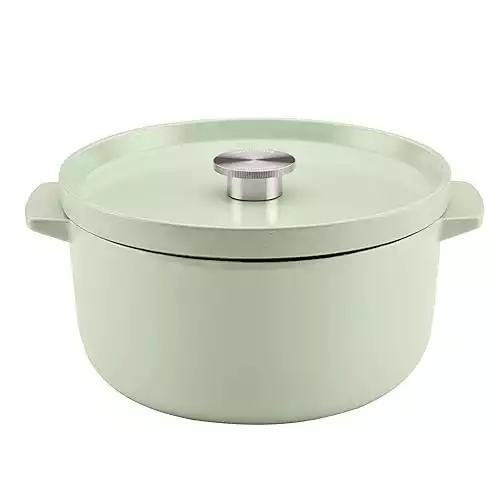As a seasoned restaurant chef with a decade of experience, I understand the importance of choosing the right cookware. That’s why I’m excited to present this comprehensive comparison of the HexClad Dutch Oven and the KitchenAid Dutch Oven. In this review, we’ll delve into the core aspects that make a Dutch oven stand out, examining each model based on ten essential criteria. This comparison aims to provide you with the necessary information to make a well-informed decision for your kitchen needs.
Our evaluation focuses on the following key features of a Dutch oven:
- Material
- Weight
- Heat retention and compatibility
- Lid fit
- Handles and product design
- Colors
- Maintenance and cleaning
- Durability and performance
- Warranty
- Price
|
Our Rating:
4.2
|
Our Rating:
3.1
|
|
Pros:
|
Pros:
|
|
Cons:
|
Cons:
|
- Stainless steel make and innovative hexagonal non-stick surface
- Lightweight
- Excels in heat retention
- Lid provides a snug fit
- Practical and ergonomic handles
- Limited lifetime warranty
- Not so expensive
- Non-stick coating may not meet some users' expectations
- Worse durability
- Weight is manageable
- Good heat retention capabilities
- More affordable
- Worse material
- Minor issue with lid stability
- Handles lack secure grip holes
- The enamel may become chipped
- Less robust and substantial compared to premium options
- One-year warranty
These two Dutch ovens didn’t find a place in the TOP-5 best Dutch ovens list for a few reasons, but they’re still solid choices.
Join me as we explore and contrast these Dutch ovens’ qualities through a practical cooking test, ensuring you choose the best one for your culinary adventures.
In this review, I provide an independent assessment of the pros and cons of HexClad and KitchenAid, based on my experience as a chef. If you choose to purchase it, please consider using the referral links included in this article. I earn a small commission from your purchases at no additional cost to you, which helps support this blog. Thank you!
Hexclad VS KitchenAid: Material
| HexClad | KitchenAid |
|---|---|
| The HexClad Dutch Oven stands out with its stainless steel make and innovative hexagonal non-stick surface. It’s safe, free from toxins and PFOA, and utilizes a combination of ceramic, diamond dust, and stainless steel for optimal performance. | The KitchenAid Dutch oven is made of cast iron with an enamel coating. It offers a robust and rust-resistant build. However, I find its cast iron thickness slightly less substantial than other Dutch oven brands. |
Hexclad VS KitchenAid: Weight
| HexClad | KitchenAid |
|---|---|
| HexClad is lightweight due to its stainless steel construction. | This Dutch oven‘s weight is manageable. It can be easily lifted and maneuvered even if loaded with food. |
Hexclad VS KitchenAid: Heat Retention and Compatibility
| HexClad | KitchenAid |
|---|---|
| The HexClad Dutch oven excels in heat retention. Its tri-ply design, incorporating an aluminum layer between two stainless steel layers, ensures exceptional heat distribution, resulting in consistent cooking temperatures.
This Dutch oven’s heat compatibility is also impressive. It can be used on gas, electric, and induction stovetops and in ovens up to 500 degrees Fahrenheit. |
The KitchenAid Dutch oven demonstrated good heat retention capabilities, maintaining a consistent temperature during braising for optimal results. Additionally, its wide heat compatibility, suitable for various stovetops and oven use up to 500 degrees Fahrenheit, ensures versatility in cooking methods. |
Hexclad VS KitchenAid: Lid Fit
| HexClad | KitchenAid |
|---|---|
| The HexClad Dutch oven‘s lid provides a snug fit, effectively sealing moisture and flavors while braising.
This Dutch oven’s heat compatibility is also impressive. It can be used on gas, electric, and induction stovetops and in ovens up to 500 degrees Fahrenheit. |
The self-basting lid creates an effective seal to retain moisture and flavor in the Dutch oven. However, there’s a minor issue with lid stability, causing steam leakage when the pot is moved, especially during extended cooking sessions. |
Hexclad VS KitchenAid: Handles and Product Design
| HexClad | KitchenAid |
|---|---|
| The handles of HexClad are practical and ergonomic. I can firmly grasp the pot even when using oven mitts. This Dutch oven has a clean and classic style that will complement any kitchen. | The Dutch oven‘s side handles lack secure grip holes, making it challenging to hold firmly. Despite this, the overall design is elegant and minimalistic, making it visually appealing for serving dishes. |
Hexclad VS KitchenAid: Colors
| HexClad | KitchenAid |
|---|---|
| HexClad is exclusively offered in its signature stainless steel design with a round shape in a 5-quart size. | The KitchenAid Enameled Cast Iron Dutch Oven is available in a few color options, such as pistachio and blue velvet. The color choices are relatively limited compared to other Dutch ovens that offer a more extensive selection of shapes, sizes, and colors. |
Hexclad VS KitchenAid: Maintenance and Cleaning
| HexClad | KitchenAid |
|---|---|
| HexClad has a non-stick surface, making cleaning effortless with a simple wipe or gentle scrub. However, it’s essential to consider that the long-term durability of this non-stick coating may not meet some users’ expectations. | Cleaning the KitchenAid Dutch oven is easy due to its enamel coating, but it displayed signs of chipping after a few uses. |
Hexclad VS KitchenAid: Durability and Performance
| HexClad | KitchenAid |
|---|---|
| The HexClad Dutch Oven offers outstanding cooking performance, delivering tender and flavorful results with various dishes, including short ribs, soups, stews, and searing meats. However, I think it may not match the longevity of cast iron Dutch ovens. | The KitchenAid Dutch oven performed adequately for a specific cooking task but felt less robust and substantial compared to premium options. It’s suitable for occasional home use but may not be as durable for professional kitchen demands. |
Hexclad VS KitchenAid: Warranty
| HexClad | KitchenAid |
|---|---|
| HexClad provides a limited lifetime warranty similar to other leading Dutch oven brands. | This Dutch oven includes a one-year warranty for added reassurance regarding its durability. Nevertheless, it is best to invest in high-end brands that offer better value for the price. |
Hexclad VS KitchenAid: Price
| HexClad | KitchenAid |
|---|---|
| HexClad costs more than the other Dutch oven, mainly due to its patented technology. | The KitchenAid Dutch Oven is affordable. |
Cooking Test

I conducted a cooking test between the KitchenAid and HexClad Dutch Ovens to examine their performance based on three key parameters.
Browning

The KitchenAid and HexClad Dutch Ovens both excel in browning food. Their impressive heat retention and uniform heat distribution provide an ideal setting for developing a rich and flavorful sear on meats and various other ingredients.
Moisture Retention
HexClad does a good job at moisture retention, it maintains a satisfactory level of moisture in dishes.
On the other hand, a minor steam leak is observed in KitchenAid Dutch Oven. While it is not a significant flaw, the short ribs from HexClad Dutch Oven turned out to be more tender.
Final Flavor

The cast iron construction enhances the final flavor of dishes cooked in the KitchenAid Dutch Oven. It imparts a rich and deep flavor to the food, especially in slow-cooked dishes.
On the other hand, the HexClad Dutch Oven, with its stainless steel and non-stick surface, may not infuse the same depth of flavor as cast iron, but it still preserves and enhances the taste of the dishes.
How We Tested
To ensure an objective and detailed comparison of the KitchenAid and HexClad Dutch Ovens, we adopted a structured method for testing their culinary performance.
Our first test involved assessing each Dutch oven’s ability to brown ingredients. By searing various cuts of meat and other items, we evaluated their capacity to create a uniform and rich crust. For a balanced comparison, the same cooking duration and heat settings were used for both Dutch ovens.
We then examined how effectively each Dutch oven maintained moisture during cooking. By observing and measuring the moisture content at different stages, we compared their abilities to retain it, which is crucial for certain recipes.
Finally, to determine the influence on overall taste, we prepared the same recipes in both Dutch ovens. We compared the flavors of the meals cooked in each, noting any variances in taste and depth, to see how each Dutch oven affected the final outcome.
Conclusion: HexClad is The Winner
|
Our Rating:
4.2
|
Our Rating:
3.1
|
|
Pros:
|
Pros:
|
|
Cons:
|
Cons:
|
- Stainless steel make and innovative hexagonal non-stick surface
- Lightweight
- Excels in heat retention
- Lid provides a snug fit
- Practical and ergonomic handles
- Limited lifetime warranty
- Not so expensive
- Non-stick coating may not meet some users' expectations
- Worse durability
- Weight is manageable
- Good heat retention capabilities
- More affordable
- Worse material
- Minor issue with lid stability
- Handles lack secure grip holes
- The enamel may become chipped
- Less robust and substantial compared to premium options
- One-year warranty
In conclusion, after conducting an in-depth comparison and practical cooking test between the HexClad and KitchenAid Dutch Ovens, it’s clear that the HexClad Dutch Oven emerges as the winner in this culinary showdown.
As a seasoned restaurant chef with over a decade of experience, I appreciate the nuances that distinguish great cookware. The HexClad Dutch Oven stands out in several key areas. Its innovative design combining stainless steel and a non-stick surface not only facilitates easy cleaning but also delivers consistently excellent cooking performance. Whether it’s browning meats or simmering stews, the HexClad Dutch Oven maintains an optimal balance of heat distribution and moisture retention, ensuring that every dish is cooked to perfection.
While the KitchenAid Dutch Oven holds its own in terms of browning capabilities and adds a certain depth of flavor to slow-cooked dishes, it falls slightly short in terms of durability and versatility. The HexClad’s ergonomic handles and superior lid fit further contribute to its practicality and efficiency in a busy kitchen environment.
Moreover, HexClad’s commitment to quality is evident in its limited lifetime warranty, offering peace of mind and assurance of a long-lasting product. Though it comes at a higher price point, the investment in HexClad is justified by its superior performance and durability.
Overall, for those seeking a reliable, versatile, and high-performing Dutch Oven, the HexClad is the clear choice. It not only meets the demands of professional chefs but also caters to the needs of home cooks looking for a touch of gourmet excellence in their kitchen.
However, if you are looking for an affordable Dutch oven for home cooking, then, HexClad, might be a good option for you. If you decide to purchase it, please use my referral link.
Take a moment to browse through the list of the best Dutch ovens.



